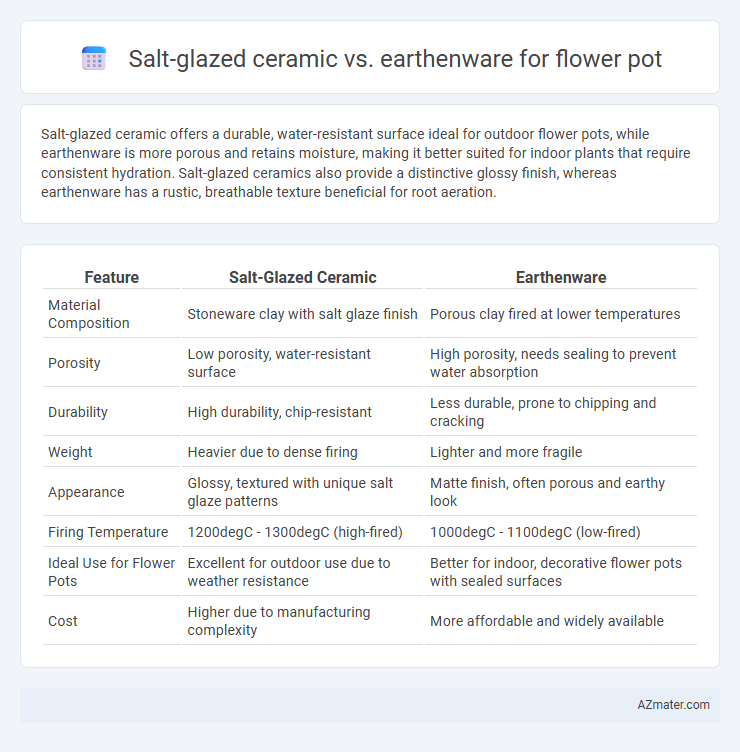Salt-glazed ceramic offers a durable, water-resistant surface ideal for outdoor flower pots, while earthenware is more porous and retains moisture, making it better suited for indoor plants that require consistent hydration. Salt-glazed ceramics also provide a distinctive glossy finish, whereas earthenware has a rustic, breathable texture beneficial for root aeration.
Table of Comparison
| Feature | Salt-Glazed Ceramic | Earthenware |
|---|---|---|
| Material Composition | Stoneware clay with salt glaze finish | Porous clay fired at lower temperatures |
| Porosity | Low porosity, water-resistant surface | High porosity, needs sealing to prevent water absorption |
| Durability | High durability, chip-resistant | Less durable, prone to chipping and cracking |
| Weight | Heavier due to dense firing | Lighter and more fragile |
| Appearance | Glossy, textured with unique salt glaze patterns | Matte finish, often porous and earthy look |
| Firing Temperature | 1200degC - 1300degC (high-fired) | 1000degC - 1100degC (low-fired) |
| Ideal Use for Flower Pots | Excellent for outdoor use due to weather resistance | Better for indoor, decorative flower pots with sealed surfaces |
| Cost | Higher due to manufacturing complexity | More affordable and widely available |
Introduction to Salt-Glazed Ceramic and Earthenware
Salt-glazed ceramics feature a distinctive glossy, textured surface created by throwing salt into the kiln at high temperatures, producing a durable, water-resistant finish ideal for flower pots exposed to outdoor elements. Earthenware, made from porous clay fired at lower temperatures, offers a more breathable but less durable alternative, requiring glazing to enhance moisture retention and strength. Choosing between salt-glazed ceramic and earthenware depends on the desired balance between durability, aesthetic texture, and moisture control for the plant environment.
Defining Characteristics of Salt-Glazed Ceramic Pots
Salt-glazed ceramic flower pots exhibit a distinct, glossy, and slightly textured surface created by introducing salt into the kiln during firing, which reacts with silica to form a durable sodium-silicate glaze. These pots are highly resistant to moisture and weathering, making them ideal for outdoor use compared to porous earthenware that absorbs water and is prone to cracking. The unique chemical reaction resulting in a glass-like coating not only enhances durability but also gives salt-glazed ceramics their characteristic orange peel texture and subtle color variations.
Features and Properties of Earthenware Flower Pots
Earthenware flower pots are porous and breathable, allowing for excellent air and moisture exchange that promotes healthy root growth, unlike salt-glazed ceramics which are less permeable due to their vitrified surface. These pots are typically made from natural clay fired at lower temperatures, resulting in a more fragile but lightweight structure that absorbs water, helping plants stay hydrated without waterlogging. The earthy, matte finish of earthenware enhances soil aeration and temperature regulation, making them ideal for plants requiring well-drained conditions.
Durability Comparison: Salt-Glazed vs Earthenware
Salt-glazed ceramics exhibit superior durability compared to earthenware due to their vitrified, non-porous surface created through high-temperature firing, making them highly resistant to moisture penetration and weathering. Earthenware pots, fired at lower temperatures, remain porous and more susceptible to chipping, cracking, and water absorption, which can compromise long-term structural integrity. For flower pots exposed to outdoor elements, salt-glazed ceramics offer enhanced longevity and reduced maintenance over traditional earthenware options.
Porosity and Water Retention Abilities
Salt-glazed ceramic flower pots display lower porosity due to their vitrified surface, resulting in reduced water absorption and enhanced durability against moisture-related damage. Earthenware pots have higher porosity, allowing greater water retention and better airflow to plant roots but require more frequent watering to prevent drying out. The choice between salt-glazed ceramic and earthenware should consider plant water needs and environmental conditions for optimal growth.
Aesthetic Appeal and Surface Textures
Salt-glazed ceramics for flower pots exhibit a distinctive glossy, textured surface with subtle variations in color caused by the salt vapor reacting with the clay, creating a natural, rustic aesthetic. Earthenware flower pots offer a more porous, matte finish with earthy tones and a tactile, slightly rough texture, enhancing a traditional, handcrafted look. The choice between salt-glazed ceramic and earthenware depends on whether a glossy, dynamic surface or a warm, natural texture is desired for decorative appeal.
Cost and Availability Considerations
Salt-glazed ceramic flower pots typically cost more due to their labor-intensive production process and durable, glass-like finish, making them less widely available than the more common and affordable earthenware options. Earthenware pots, made from natural clay and fired at lower temperatures, are generally budget-friendly and readily accessible in most garden centers. Choosing between the two depends on prioritizing cost-effectiveness and availability versus long-term durability and aesthetic appeal.
Suitability for Different Types of Plants
Salt-glazed ceramic pots offer a dense, non-porous surface that retains moisture well, making them ideal for moisture-loving plants like ferns and tropical species. Earthenware pots are porous and allow better airflow and drainage, which benefits succulents, cacti, and drought-tolerant plants by preventing root rot. Understanding the water and aeration requirements of specific plant types guides the choice between salt-glazed ceramic and earthenware for optimal growth and health.
Maintenance and Longevity of Each Material
Salt-glazed ceramics offer superior durability and a dense, non-porous surface that resists moisture absorption, leading to lower maintenance and longer lifespan compared to earthenware. Earthenware flower pots are more porous and prone to chipping or cracking, requiring more frequent cleaning and careful handling to prevent water damage. For extended outdoor use, salt-glazed pots withstand weathering better, whereas earthenware may degrade faster without protective sealing.
Which is Better for Flower Pots: Final Verdict
Salt-glazed ceramic offers superior durability and water resistance compared to earthenware, making it more suitable for outdoor flower pots exposed to moisture and weather changes. Earthenware pots are more porous and lightweight, promoting better aeration for plant roots but require frequent watering and careful handling to avoid chipping. For longevity and moisture retention, salt-glazed ceramic is better, while earthenware is preferred for breathability and traditional aesthetics.

Infographic: Salt-glazed ceramic vs Earthenware for Flower Pot
 azmater.com
azmater.com